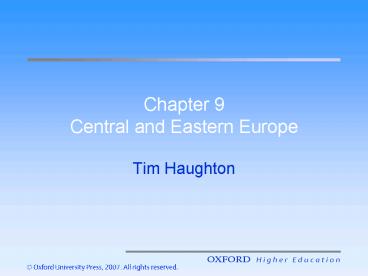Chapter 9 Central and Eastern Europe - PowerPoint PPT Presentation
1 / 10
Title:
Chapter 9 Central and Eastern Europe
Description:
Tendency to prefer Central' to Eastern' European label. Diversity as hallmark of Central and Eastern Europe (CEE) The Post-Communist Challenge ... – PowerPoint PPT presentation
Number of Views:56
Avg rating:3.0/5.0
Title: Chapter 9 Central and Eastern Europe
1
Chapter 9Central and Eastern Europe
- Tim Haughton
2
Central and Eastern Europe
- The Post-Communist Challenge
- The Institutional Framework
- Salient Issues
- EU Conditionality
- EU Membership
- Continued Commonality or Increasing Diversity?
3
Introduction
- Eastern enlargement has had big impact on
European politics - Tendency to prefer Central to Eastern
European label - Diversity as hallmark of Central and Eastern
Europe (CEE)
4
The Post-Communist Challenge
- Challenges facing post-1989 CEECs
- Create democracies
- Create market economies
- Build new states (except Poland, Hungary)
- How to manage privatization?
- How to move towards pluralism?
5
The Institutional Framework
- Decisions made in 1989-91 are key
- Prevailing model
- Parliamentary democracy
- Proportional representation electoral system
- Multiparty systems
- Coalition governments
6
Salient issues
- Attitudes to communist past
- Speed, direction and extent of economic reform
- EU integration
- Ethnic politics and minority policies
- Morality and values
- Competence, corruption and valence
7
The Role of EU Conditionality
- Initial response to end of communism PHARE
bilateral Europe Agreements - Copenhagen Criteria
- Copenhagen, 2002 CEE 8 invited to join EU
- 1 May 2004 CEE 8 join EU
8
Impact of EU Conditionality
- Incorporation of acquis communautaire into
domestic law - Includes bypassing of domestic legislative
processes - More opportunity for CEE autonomy in policy areas
with weak EU powers - EU promotes ethnic minority rights
- Continued role for domestic politics
9
The Impact of EU Membership
- 8 CEECs are now EU subjects, rather than objects
- National civil servants must have strong grasp of
EU law/policymaking - New CEECs have sought to re-direct EU external
relations towards Eastern borders - New CEECs not yet members of Schengen or EMU
10
Continued Commonality or Increasing Diversity?
- Common response to globalization?
- Broad patterns, with significant variations, more
likely - Common history amongst CEECs, but that history is
becoming decreasingly relevant












![Chapter 18: Cold War Conflicts [1945-1991] PowerPoint PPT Presentation](https://s3.amazonaws.com/images.powershow.com/7237467.th0.jpg?_=20151008125)


















